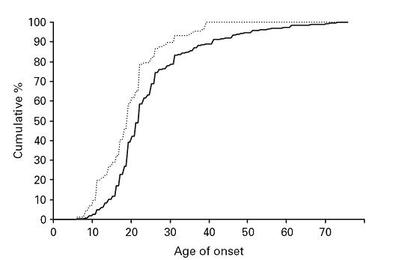The WAGER 13(6) – Gambling: When Getting an Early Start Might Not be Such a Good Idea
Past WAGERS (see WAGER 13(3) and WAGER 13(2))explored results from Kessler’s analysis of the National Comorbidity Survey Replication (NCS-R) data on odds of recovery and the relationship between types of gambling and gambling problems (Kessler et al., 2008). This week’s WAGER examines the differences in age of onset (AOO) for gambling between people who gamble and do not report ever having any problems (non-problem gamblers) and those who do report problems at some point in their life (problem gamblers). In addition, this WAGER will look at the AOO for problems among people with varying numbers of problems.
The US National Comorbidity Survey Replication (NCS-R) survey is a face-to-face household survey used to obtain information about the prevalence of co-occurring disorders in the US population. Kessler et al. used the Composite International Diagnostic Interview (CIDI) to study AOO differences among gamblers. A comparison of the two curves illustrated in Figure 1 shows that non-problem gamblers start gambling at significantly later ages than problem gamblers. Among problem gamblers, people with three or more problems experience problems significantly sooner (p = .049) after beginning to gamble than people with one or two problems. A smaller segment of problem gamblers, pathological gamblers (PG), also have significantly less average number of years between their first gambling experience and their most recent gambling problem.
Figure 1: Age of onset of gambling among non-problem gamblers & problem gamblers.

Notes: Non-problem gamblers (─, n=2624), problem gamblers (▪▪▪▪, n=117).
As with all survey-based data, the retrospective recall-based nature of the questions limits Kessler et al’s results. Although this is an important limitation, researchers anticipated this problem. They used a special question sequence to reduce error and hopefully obtain more trustworthy results. They included questions such as “can you remember your exact age the very first time [emphasis in original] when you (had the symptom/the syndrome)?” to prompt for the most accurate response possible. Participants who expressed uncertainty were further probed with questions like “was it before you went to school?” and “was it before age 13?”
All gamblers have varying gambling experiences (i.e., onset age, treatment attempts, gambling involvement); an understanding of AOO differences within a gambling disorder could prove useful to clinicians. The earlier a gambler’s AOO the more likely it seems that they will experience symptoms correlated with pathological gambling. Further research relating the relationship between AOO and PG symptoms to odds of recovery and types of gambling would provide researchers and clinicians with a clearer framework with which to diagnose problem gambling.
What do you think? Comments can be addressed to Ingrid R. Maurice.
References
Kessler, R. C., Hwang, I., LaBrie, R. A., Petukhova, M., Sampson, N. A., Winters, K. C., Shaffer, H. J. (2008). DSM-IV Pathological Gambling in the National Comorbidity Survey Replication. Psychological Medicine, Cambridge University Press. DOI: 10.1017/S0033291708002900